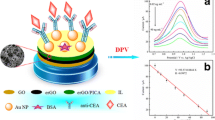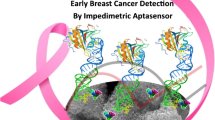Abstract
The authors report on an electrochemical immunosensor for the tumor marker carbohydrate antigen 15–3 (CA15–3). It is based on the use of a composite consisting of reduced graphene oxide (RGO) and copper sulfide (CuS) that was placed on a screen-printed graphite electrode. The electrode shows excellent activity towards the oxidation of catechol acting as an electrochemical probe, best at a working potential of 0.16 V. The electrode was modified with antibody against CA15–3. Once the analyte (CA15–3) binds to the surface of the electrode, the response to catechol is reduced. The assay has a linear response in the 1.0–150 U mL−1 CA15–3 concentration range, with a 0.3 U mL−1 lower detection limit and a sensitivity of 1.88 μA μM−1 cm−2. The immunosensor also shows good reproducibility (2.7%), stability (95% of the initial values after storing for four weeks). The method was successfully applied to the determination of CA15–3 in serum samples, and results were found to compare well to those obtained by an ELISA. Conceivably, this nanocomposite based detection scheme has a wider scope and may be applied to numerous other immunoassays.

A label-free electrochemical immunosensor based on copper sulfides/graphene nanocomposites was developed for enzyme-free determination of CA15–3 biomarker. This immunosensor can be utilized as a tool to detect of CA15–3 in real samples.






Similar content being viewed by others
References
Wu J, Fu Z, Yan F, Ju H (2007) Biomedical and clinical applications of immunoassays and immunosensors for tumor markers. TrAC Trends Anal Chem 26:679–688
Müller V, Stahmann N, Riethdorf S et al (2005) Circulating tumor cells in breast cancer: correlation to bone marrow micrometastases, heterogeneous response to systemic therapy and low proliferative activity. Clin Cancer Res 11:3678–3685
Liu A, Zhao F, Zhao Y et al (2016) A portable chemiluminescence imaging immunoassay for simultaneous detection of different isoforms of prostate specific antigen in serum. Biosens Bioelectron 81:97–102
Zhang L, He Y, Wang H et al (2015) A self-enhanced electrochemiluminescence immunosensor based on l-Lys-Ru functionalized porous six arrises column nanorods for detection of CA15-3. Biosens Bioelectron 74:924–930
Ambrosi A, Airo F, Merkoçi A (2009) Enhanced gold nanoparticle based ELISA for a breast cancer biomarker. Anal Chem 82:1151–1156
Wang G, Qing Y, Shan J et al (2013) Cation-exchange antibody labeling for simultaneous electrochemical detection of tumor markers CA15-3 and CA19-9. Microchim Acta 180:651–657
Mazloum-Ardakani M, Hosseinzadeh L, Khoshroo A (2015) Ultrasensitive electrochemical Immunosensor for detection of tumor necrosis factor-α based on functionalized MWCNT-gold nanoparticle/ionic liquid nanocomposite. Electroanalysis 27:2518–2526
Zhang A, Huang C, Shi H et al (2017) Electrochemiluminescence immunosensor for sensitive determination of tumor biomarker CEA based on multifunctionalized flower-like Au@ BSA nanoparticles. Sensors Actuators B Chem 238:24–31
Mazloum-Ardakani M, Hosseinzadeh L, Khoshroo A (2015) Label-free electrochemical immunosensor for detection of tumor necrosis factor α based on fullerene-functionalized carbon nanotubes/ionic liquid. J Electroanal Chem 757:58–64
Roushani M, Valipour A (2016) Voltammetric immunosensor for human chorionic gonadotropin using a glassy carbon electrode modified with silver nanoparticles and a nanocomposite composed of graphene, chitosan and ionic liquid, and using riboflavin as a redox probe. Microchim Acta 183:845–853
Li W, Yuan R, Chai Y, Chen S (2010) Reagentless amperometric cancer antigen 15-3 immunosensor based on enzyme-mediated direct electrochemistry. Biosens Bioelectron 25:2548–2552
Kurtinaitiene B, Ambrozaite D, Laurinavicius V et al (2008) Amperometric immunosensor for diagnosis of BLV infection. Biosens Bioelectron 23:1547–1554
Li Y, Xu C, Li H et al (2014) Nonenzymatic immunosensor for detection of carbohydrate antigen 15-3 based on hierarchical nanoporous PtFe alloy. Biosens Bioelectron 56:295–299
Zhao L, Wei Q, Wu H et al (2014) Ionic liquid functionalized graphene based immunosensor for sensitive detection of carbohydrate antigen 15-3 integrated with Cd2+-functionalized nanoporous TiO2 as labels. Biosens Bioelectron 59:75–80
Li H, He J, Li S, Turner APF (2013) Electrochemical immunosensor with N-doped graphene-modified electrode for label-free detection of the breast cancer biomarker CA 15-3. Biosens Bioelectron 43:25–29
Hosseinzadeh L, Abassi S, Ahmadi F (2007) Adsorptive cathodic stripping voltammetry determination of ultra trace of lead in different real samples. Anal Lett 40:2693–2707
Ganjali MR, Rahimi-Nasrabadi M, Maddah B et al (2004) Sub-micro level monitoring of beryllium ions with a novel beryllium sensor based on 2, 6-diphenyl-4-benzo-9-crown-3-pyridine. Talanta 63:899–906
Ganjali MR, Gholivand MB, Rahimi-Nasrabadi M, Maddah B, Salavati-Niasari M, Ahmadi F (2006) Synthesis of a new octadentates Schiff's base and its application in construction of a highly selective and sensitive lanthanum (III) membrane sensor. Sens Lett 4:356–363
Shan J, Ma Z (2017) A review on amperometric immunoassays for tumor markers based on the use of hybrid materials consisting of conducting polymers and noble metal nanomaterials. Microchim Acta 148:969–979
Gao Z, Lin Y, He Y, Tang D (2017) Enzyme-free amperometric glucose sensor using a glassy carbon electrode modified with poly(vinyl butyral) incorporating a hybrid nanostructure composed of molybdenum disulfide and copper sulfide. Microchim Acta 184:807–814
Rahimi-Nasrabadi M, Khoshroo A, Mazloum-Ardakani M (2017) Electrochemical determination of diazepam in real samples based on fullerene-functionalized carbon nanotubes/ionic liquid nanocomposite. Sensors Actuators B Chem 240:125–131
Pandey CM, Tiwari I, Singh VN et al (2017) Highly sensitive electrochemical immunosensor based on graphene-wrapped copper oxide-cysteine hierarchical structure for detection of pathogenic bacteria. Sensors Actuators B Chem 238:1060–1069
Ali MA, Mondal K, Wang Y et al (2017) In situ integration of graphene foam–titanium nitride based bio-scaffolds and microfluidic structures for soil nutrient sensors. Lab Chip 17:247–285
Liu N, Nie D, Tan Y et al (2017) An ultrasensitive amperometric immunosensor for zearalenones based on oriented antibody immobilization on a glassy carbon electrode modified with MWCNTs and AuPt nanoparticles. Microchim Acta 184:147–153
Xie X, Ao Z, Su D et al (2015) MoS2/graphene composite anodes with enhanced performance for sodium-ion batteries: the role of the two-dimensional Heterointerface. Adv Funct Mater 25:1393–1403
Tang D, Hou L, Niessner R et al (2013) Multiplexed electrochemical immunoassay of biomarkers using metal sulfide quantum dot nanolabels and trifunctionalized magnetic beads. Biosens Bioelectron 46:37–43
Pourmortazavi SM, Hajimirsadeghi SS, Rahimi-Nasrabadi M (2009) Statistical optimization of condition for synthesis lead sulfide nanoparticles. Mater Manuf Process 24:524–528
Yu X, Cao C, Zhu H et al (2007) Nanometer-sized copper sulfide hollow spheres with strong optical-limiting properties. Adv Funct Mater 17:1397–1401
Xie Y, Carbone L, Nobile C et al (2013) Metallic-like stoichiometric copper sulfide nanocrystals: phase-and shape-selective synthesis, near-infrared surface plasmon resonance properties, and their modeling. ACS Nano 7:7352–7369
Lee H, Yoon SW, Kim EJ, Park J (2007) In-situ growth of copper sulfide nanocrystals on multiwalled carbon nanotubes and their application as novel solar cell and amperometric glucose sensor materials. Nano Lett 7:778–784
Feng C, Zhang L, Yang M et al (2015) One-pot synthesis of copper sulfide nanowires/reduced graphene oxide nanocomposites with excellent lithium-storage properties as anode materials for lithium-ion batteries. ACS Appl Mater Interfaces 7:15726–15734
Huang X, Yin Z, Wu S et al (2011) Graphene-based materials: synthesis, characterization, properties, and applications. Small 7:1876–1902
Geim AK (2009) Graphene: status and prospects. Science 324:1530–1534
Rahimi-Nasrabadi M, Rostami M, Ahmadi F et al (2016) Synthesis and characterization of ZnFe2− xYbxO4–graphene nanocomposites by sol–gel method. J Mater Sci Mater Electron 27:11940–11945
Rostami M, Rahimi-Nasrabadi M, Ganjali MR et al (2017) Facile synthesis and characterization of TiO2–graphene–ZnFe2− xTbxO4 ternary nano-hybrids. J Mater Sci 52:7008–7016
Huang K-J, Zhang J-Z, Liu Y, Liu Y-M (2015) Synthesis of reduced graphene oxide wrapped-copper sulfide hollow spheres as electrode material for supercapacitor. Int J Hydrog Energy 40:10158–10167
Zhang Y, Tian J, Li H et al (2012) Biomolecule-assisted, environmentally friendly, one-pot synthesis of CuS/reduced graphene oxide nanocomposites with enhanced photocatalytic performance. Langmuir 28:12893–12900
Marcano DC, Kosynkin DV, Berlin JM et al (2010) Improved synthesis of graphene oxide. ACS Nano 4:4806–4814
Mazloum-Ardakani M, Hosseinzadeh L, Taleat Z (2014) Two kinds of electrochemical immunoassays for the tumor necrosis factor α in human serum using screen-printed graphite electrodes modified with poly(anthranilic acid). Microchim Acta 181:917–924
Yannopoulos SI, Lyberatos G, Theodossiou N et al (2015) Evolution of water lifting devices (pumps) over the centuries worldwide. Water 7:5031–5060
Valipour M (2016) Optimization of neural networks for precipitation analysis in a humid region to detect drought and wet year alarms. Meteorol Appl 23:91–100
Valipour M (2015) Study of different climatic conditions to assess the role of solar radiation in reference crop evapotranspiration equations. Arch Agron Soil Sci 61:679–694
Valipour M (2012) Number of required observation data for rainfall forecasting according to the climate conditions. Am J Sci Res 74:79–86
Valipour M (2013) Increasing irrigation efficiency by management strategies: cutback and surge irrigation. ARPN J Agric Biol Sci 8:35–43
Chang C-C, Chiu N-F, Lin DS et al (2010) High-sensitivity detection of carbohydrate antigen 15-3 using a gold/zinc oxide thin film surface plasmon resonance-based biosensor. Anal Chem 82:1207–1212
Darwish IA, Wani TA, Khalil NY, Blake DA (2012) Novel automated flow-based immunosensor for real-time measurement of the breast cancer biomarker CA15-3 in serum. Talanta 97:499–504
Zhang X, Peng X, Jin W (2006) Scanning electrochemical microscopy with enzyme immunoassay of the cancer-related antigen CA15-3. Anal Chim Acta 558:110–114
Acknowledgements
The authors wish to thank the National Institute for Medical Research Development (NIMAD) for their support (Grant No. 957254).
Author information
Authors and Affiliations
Corresponding author
Ethics declarations
The authors declare that they have no competing interests.
Rights and permissions
About this article
Cite this article
Amani, J., Khoshroo, A. & Rahimi-Nasrabadi, M. Electrochemical immunosensor for the breast cancer marker CA 15–3 based on the catalytic activity of a CuS/reduced graphene oxide nanocomposite towards the electrooxidation of catechol. Microchim Acta 185, 79 (2018). https://doi.org/10.1007/s00604-017-2532-5
Received:
Accepted:
Published:
DOI: https://doi.org/10.1007/s00604-017-2532-5




